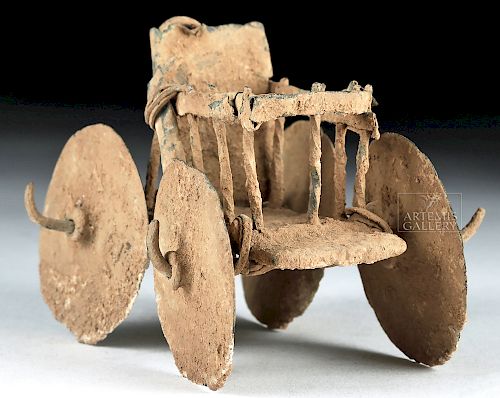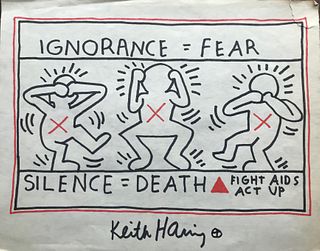Rare Anatolian Bronze Wheeled Cart Toy
Lot 89a
About Seller
Artemis Fine Arts
686 S Taylor Ave, Ste 106
Louisville, CO 80027
United States
Selling antiquities, ancient and ethnographic art online since 1993, Artemis Gallery specializes in Classical Antiquities (Egyptian, Greek, Roman, Near Eastern), Asian, Pre-Columbian, African / Tribal / Oceanographic art. Our extensive inventory includes pottery, stone, metal, wood, glass and textil...Read more
Categories
Estimate:
$2,500 - $3,500
Absentee vs Live bid
Two ways to bid:
- Leave a max absentee bid and the platform will bid on your behalf up to your maximum bid during the live auction.
- Bid live during the auction and your bids will be submitted real-time to the auctioneer.
Bid Increments
| Price | Bid Increment |
|---|---|
| $0 | $25 |
| $300 | $50 |
| $1,000 | $100 |
| $2,000 | $250 |
| $5,000 | $500 |
| $10,000 | $1,000 |
| $20,000 | $2,500 |
| $50,000 | $5,000 |
| $100,000 | $10,000 |
| $200,000 | $20,000 |
About Auction
By Artemis Fine Arts
May 10, 2018
Set Reminder
2018-05-10 10:00:00
2018-05-10 10:00:00
America/New_York
Bidsquare
Bidsquare : Fine Ethnographic / Asian / Ancient Art
https://www.bidsquare.com/auctions/artemis-gallery/fine-ethnographic-asian-ancient-art-3213
Featuring antiquities from around the world including Pre-Columbian, Tribal, Classical, Asian, so much more! Artemis Fine Arts info@artemisgallery.com
Featuring antiquities from around the world including Pre-Columbian, Tribal, Classical, Asian, so much more! Artemis Fine Arts info@artemisgallery.com
- Lot Description
Asia Minor, modern-day Turkey, Anatolia, Early Bronze Age, ca. 2nd millennium BCE. A bronze toy cart complete with all four original wheels. The cart has a rectangular platform made from a thin sheet of hammered bronze, with a pair of axles secured along the underside with thin bronze strips. Perforated discoid wheels are secured onto each axle with small bends at the terminals, and are sufficiently spaced apart so as to not grind against one another. A carriage is comprised of eleven twisted bronze pins, an upper border strip, and a seat back for a small toy. Three horizontal loops project from behind the seat, allowing a child to pull the cart with a small thread or bronze handle. Though covered in copious amounts of earthen material, miniscule areas of blue-grey and green hued patina are visible. Evocative of the simplicity of Bronze Age artwork, this is a captivating and exceedingly rare example! Size: 3.875" L x 3" W x 2.625" H (9.8 cm x 7.6 cm x 6.7 cm).
This artifact is a wonderful representation of childhood innocence, discovery, and the lengths at which adults will go to inspire and please a child. Toys fashioned from terracotta, bone, or other readily-available materials would have been the norm in ancient times, so one created from bronze would have been something truly special. Other examples of bronze toy carts have been found throughout parts of Mesopotamia, Syria, and Anatolia, suggesting that the appeal and popularity of toys was quite prevalent throughout the ancient world despite the painstaking process needed to create such a plaything.
Similar examples have been found to have only two wheels, presumably to be pulled by oxen, though examples of the four-wheeled variety have been uncovered as well with camels attached to accompanying reins. The climate during this time was becoming increasingly arid, and the camel became the main draft animal in ancient Asia Minor and in western Central Asia.
What were models like this one used for? They seem to have had a votive purpose, perhaps made to be placed into tombs to replicate the conditions and possessions of life for the deceased. Imagine a cart like this piled high with exotic goods, traveling between the great civilizations of the ancient Near East, Asia Minor, northern India, and beyond.
A similar example with accompanying oxen hammered for GBP 50,000 ($69,895.50) at Christie's London Antiquities Auction (April 2 , 2014), lot 30: https://www.christies.com/lotfinder/ancient-art-antiquities/an-anatolian-bronze-chariot-circa-mid-2nd-millennium-5776268-details.aspx?from=searchresults&intObjectID=5776268&sid=e5b26082-c087-4ab8-95e0-367aeefbdc5b
For another similar example as well as a great descriptive overview of this type of toy cart, please see: Muscarella, Oscar White. Bronze and Iron: Ancient Near Eastern Artifacts in the Metropolitan Museum of Art. The Metropolitan Museum of Art, New York, 1988, pp. 414-415, fig. 568.
Provenance: private East Coast, USA collection
All items legal to buy/sell under U.S. Statute covering cultural patrimony Code 2600, CHAPTER 14, and are guaranteed to be as described or your money back.
A Certificate of Authenticity will accompany all winning bids.
We ship worldwide and handle all shipping in-house for your convenience.
#133331Losses to portions of suspension cords on verso. Repair to part of wheel near seat back. Surface wear commensurate with age, slight bending to carriage, base, axles, and wheels, with small nicks and roughness across wheels and most surfaces, otherwise excellent. Nice earthen deposits throughout. Miniscule areas of blue-grey and light-green patina visible.Condition
- Shipping Info
-
All shipping is handled in-house for your convenience. Your invoice from Artemis Gallery will include shipping calculation instructions. If in doubt, please inquire BEFORE bidding for estimated shipping costs for individual items.
-
- Buyer's Premium



 EUR
EUR CAD
CAD AUD
AUD GBP
GBP MXN
MXN HKD
HKD CNY
CNY MYR
MYR SEK
SEK SGD
SGD CHF
CHF THB
THB

















